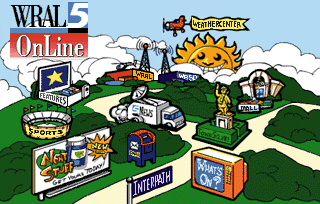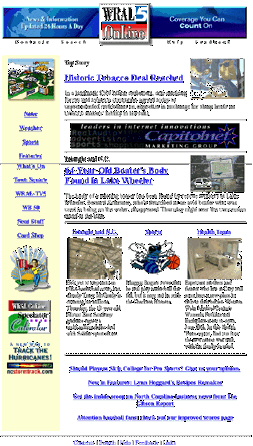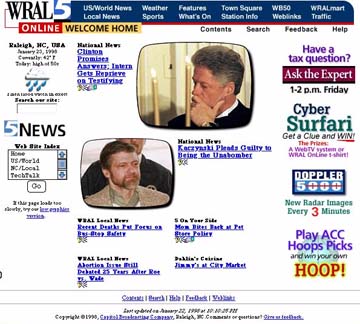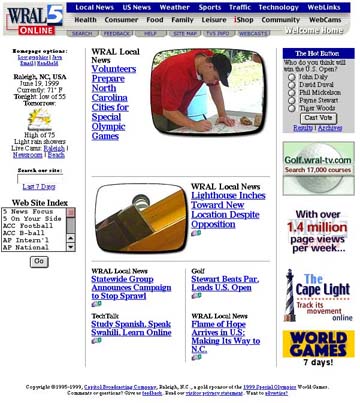| Happy
Valley and Beyond: Establishing Local Identity for Online News by Bob Stepno |
||||||||||||||||||||||||||||||||||||||||||||||||||
|
During the site's first three and a half years, the staff refined the home page as a presentation of information about both the day's news events and the site's full range of contents, including interactive features, online video, and reference links mentioned during television news broadcasts. The evolving features of WRAL OnLine suggest a blurring of technological and media-content boundaries, illustrating phenomena discussed recently by J. David Bolter and Richard Grusin under the title Remediation, as well as the changes Roger Fidler suggests in his book, Mediamorphosis. With its parent company's interests in digital broadcasting and data communications, WRAL OnLine seems worth watching. Each year
since its launch, WRAL-OnLine has made incremental changes in
form and content, as well as making alliances with other media
organizations. The first incarnation of the home page was a
cartoon of a smiling sun shining on a hillside of iconic buildings
representing different parts of the site; the "Happy Valley"
of my title. This paper suggests that the changes not only responded
to the evolving technological capabilities of Web browsers,
but have clarified the site's purpose and identity -- in relation
to the station's parent company, its other media properties,
and the local community. The designs and redesigns also illustrate
the blurring boundaries between news, entertainment, public
service, commercial and self-promotional functions of the media.
Among WRAL OnLine's features are a 24-hour-a-day approach to
national and international news, a complete archive of feature
story Web pages based on original WRAL-TV reporting since the
site's inception; integration of digital text, video, audio
and databases in local reporting; early steps in online commerce,
and attempts to encourage audience identification (or "virtual-community-building")
through bulletin boards, polls, and other interactive features.
WRAL: Corporate Context WRAL-TV is owned by Capitol Broadcasting Company, Inc., a diversified communications company that began with a single Raleigh, N.C., radio station in 1937. By 1998 Capitol Broadcasting included three television channels and a wide range of other services, and had a reputation as a technological innovator or "early adopter" through its entries into FM radio, television, digital high definition television (HDTV), and the Internet. Capitol Broadcasting's founders were Alfred J. Fletcher, a Raleigh attorney, and his son Frank, an attorney with the Federal Communications Commission. Their 250-watt WRAL-AM went on the air in 1939 as the second commercial station in the city. Fred Fletcher, another son of A.J. Fletcher, became general manager in 1942 and continued as the company's president into the 1970s. Jim Goodmon, a grandson of the founder, was company president and CEO in the 1990s. Several milestones listed in the company history involve the company's adoption of new communication technologies: starting FM broadcasts in 1946, launching its television operation in 1956, building its 2,000-foot transmitting tower in 1978 (the "tallest man-made structure east of the Mississippi River"), and hiring professional meteorologists for the newsroom staff in 1982 as the WRAL-TV Weather Center. With the launch of WRAL OnLine in January 1996, the company added the Internet to its media-technology résumé. (WRAL, 1998) An article by Goodmon, posted on the company Web site, summarizes the WRAL's image as a technological leader: Channel 5 quickly became a national leader in innovative news and community-oriented programming. Today, Channel 5 CBS continues to lead the nation in its innovative approach to communicating with its publics with the addition of WRAL OnLine, a comprehensive release of up-to-the-minute news, weather, and sports reports on the Internet and World Wide Web. (Goodmon, 1996) Goodmon is credited by the firm with its expansion into satellite communications, the Internet, and HDTV. Television Broadcast magazine named WRAL 1996 Broadcaster of the Year for being the first commercial television station in the U.S. to broadcast a high-definition digital signal. Capitol Broadcasting's other subsidiaries include Capitol Radio Networks, the Durham Bulls baseball team, the Capitolnet Marketing Group, and Microspace Communications Corporation, (satellite transmission of data, video and audio). The company owned an Internet Service Provider (ISP) business, Interpath, but sold it to the Carolina Light & Power Company in December, 1997, arguing that facilities-based telecommunications companies were better suited to the ISP business, and citing a series of start-ups, mergers or acquisitions by companies including GTE, AT&T, BellSouth and WorldCom/MCI (Capitol Broadcasting, 1997). In addition to WRAL-TV, the CBS-affiliated channel 5, Capitol Broadcasting operated several other television stations in North Carolina, either as owner or under limited marketing agreements (LMAs) with their owners: WRAZ Channel 50 in Durham (Fox), WJZY Channel 46 in Charlotte (UPN), WFVT Channel 55 in Charlotte (Warner Brothers), and WRAL-HDTV, Channel 32. The parent company and other stations also established Web sites, but without the 24-hour-a-day-news focus of WRAL OnLine. Until 1999, the WRAL OnLine home page included a link to WRAZ, but the June, 1999, redesign did not. WRAL OnLine In January, 1996, WRAL began delivering news at the Internet address http://www.wral-tv.com. It was the first Raleigh-Durham television station on the Web, establishing its presence before its national television network (CBS) went online. The Web site's own history page summarizes its features as follows: WRAL-TV5 OnLine features: highlights of WRAL's top news stories updated regularly; weather forecasts updated several times a day; sports scores and a "Play of the Day" video; a daily program schedule; "Buying Power," "Health Team," "For The Children," and other special features; shopping coupons and sponsor advertisements; information about WRAL-TV5, its mission and its people; an updated list of community events and volunteer opportunities; and, the opportunity to correspond with the staff of WRAL-TV5. (WRAL, 1998.) The original staff included a technical director (computer systems administrator and programmer), John Whitehead, who was hired a year before the launch of the Web site, while a graphic designer and news producer were being recruited from the television station's staff. WRAL OnLine's news director, John Conway, additional news producers and a second programmer were hired from outside the company to prepare for the launch in January, 1996. His primary experience was in daily newspaper journalism. Other staff members' professional experience was a cross-section of print newspaper reporting and editing, radio and television news and technical writing. By the launch date the OnLine staff had created dozens of Web pages using November and December WRAL-TV stories -- both as a "shake-down" period for the production process and as the beginning of WRAL OnLine's practice of maintaining searchable archives of its daily stories. After those shakedown weeks, the television station broadcast a five-day series of stories about the Web in February, including the formal announcement of WRAL OnLine to its home audience. A story archived at WRAL OnLine with the date Feb. 12, 1996, talks about the site's "first 24 hours of operation" being a success, suggesting the first "official" day was Feb. 11. However, the organization marked its one-year anniversary January 17, 1997. (Its online archives include stories from November and December, 1995, which were developed in preparation for regular daily operation.) During the time period of this study WRAL OnLine was housed in two offices on the first and second floors of the main WRAL-TV building in Raleigh, N.C. The upstairs office housed the Web server computers and the work stations for the two programmers and the graphic designer. The compact downstairs "newsroom" included four work stations, television monitors, video and audio recording equipment, and computers linked to both the station's internal computer system and the Internet. The four desks accommodated the four full-time and two to four part-time producers, who worked overlapping shifts. (Usually no more than three staff members used the room at a time.) The news producer and feature producer sat back-to-back at one end of the room; the sports producer and news director at the other. WRAL OnLine followed television news terminology, using the title "producer" rather than "editor." WRAL's television studios and broadcast newsroom, with a staff of more than 75 reporters and producers, were also on the first floor of the building, down a twisting corridor from the OnLine offices. The two departments shared computer printers in the connecting hallway, as well as sharing use of a conference room a few steps from the OnLine newsroom entrance. Administratively, Conway reported to the station's promotions director, and WRAL OnLine staff members sometimes contributed to projects for other parts of the organization, such as graphic designs for use on-air or in promotional publications. The Web site's original file and database structures were used by WRAL OnLine for at least three years, although the original technical director who developed them left the company shortly after the site's first full year of operation. Continuity was provided by Jason Priebe, the organization's second programmer, who joined the company a few months after the launch of the site and was promoted to technical director the next year. Both Whitehead and Priebe developed programs to automate or facilitate various kinds of text conversion and page-construction. An additional programmer was hired in May 1997, but left after a little over a year. The original visual design elements for the Web pages were created by WRAL-TV staff designers in consultation with the television station's management. The WRAL logo, weather maps and other graphics were patterned after those presented to the station's television station. Categories for the news presentation were modeled on the categories of station news and Associated Press wire service news categories: On the occasion of its first anniversary, WRAL OnLine described itself as "one of the first TV stations with a real commitment to providing 24-hour news and information," and summarized several "strengths of television" that it intended to bring to the Web: "immediacy, personality, local news, informational graphics, entertainment, community service, live audio, and most recently, live video." In that first year, the station's home page had been visited more than 1 million times, the staff had written 1,685 local news and sports stories and 942 local features, and the online archives totalled 8,300 Web pages. (WRAL, 1997) WRAL5 OnLine has presented a new or mostly-new face to its viewers once a year, with some design changes between these major "new looks." The original home page (1996-97) was a full-screen cartoon of a landscape that the staff came to refer to as "Happy Valley." A dozen objects located in the scene were "clickable" links to the main sections of the WRAL Web site. A cartoon sun with a toothy smile rose in the back of the scene, under an airplane towing a "Weather Center" banner. A football stadium was labelled "Sports"; a van with a satellite antenna on the roof was marked "News"; a television set's screen held the words "What's On?" Other features were: a shopping mall for online shopping, a drive-in theater ("Features"), a street sign marked "Interpath" (the Capitol Broadcasting Internet access company), a statue marked "Town Square," a billboard labelled "Neat Stuff" and two antenna-topped buildings in the background, marked WRAL and WRAZ (WRAL's sister station). For visitors whose browsers were incapable of displaying graphical navigation maps, the page included a text menu at the bottom- below the area of the screen devoted to the Happy Valley map. 1997 Design The 1997 home page was reminiscent of contemporary newspaper front-page designs, such as USA Today. That is, it divided the screen (or page) into distinct rectangular areas beneath a nameplate or title-bar area at the top. It presented a narrow menu at the left, stories at the right, and one- or two-line text "teases" at the bottom. The blue title bar had a "WRAL5 OnLine" logo in the center, with clickable links on the words "contents," "search," "help" and "feedback" incorporated in its bottom edge. On either side of the logo, the blue bar carried slogans, "News and information 24 hours a day" and "Coverage you can count on." (The latter being a slogan used in the broadcast station's own promotions.) While this design (Figure 2) departed from the full-screen graphical image, a smaller version of the earlier Happy Valley map now appeared as a square (c. 1.5- inch) image near the top of the page. This image was not only a reminder, but a clickable link to the original full-screen version of the home page for users who were accustomed to that means of navigating the site. On the new home page, the small Happy Valley image topped a column on the left side of the screen, including a text-only menu listing 10 major sections of the site (News, Weather, Sports, Features, etc.), and three small rectangular graphics linked to special features. (Example: "A new way to track the hurricanes!" promoting the "ncstormtrack.com" site established and promoted jointly by WRAL's meteorology staff and and the News & Observer.) To the right of this menu, the main body of the page (roughly three-fourths of its width) was divided into six display spaces, including one for an advertising banner. There were three horizontal display spaces atop three smaller vertical display spaces; the first and third horizontal spaces each included a short section label ("Top Story," "Triangle and N.C."), a longer story headline in one or two lines, a photograph (or other image, such as a sports team logo) and the first sentence or two of the story. Clicking on the story headline transported the viewer to the full text of that story. The space between the "Top Story" and the second story was used for an advertisement. On a small computer screen, only the top story and the advertisement would be visible without scrolling the screen. Lower on the screen, the three vertical spaces each held a short section label ("Sports," "Health Team" or another section of the site), an image, and the first sentence or two of a story. No headlines were used, but the section labels were linked to the full text of the story. The bottom of the page carried four one-sentence "teases" to contents of the site other than routine news stories, such as feature sections), opinion polls, or general promotion of various sections of the site. (Examples: "New in Features: Lynn Hoggard's Recipes Remakes," "Attention baseball fans: Check out our improved scores page.") News section pages followed a similar design, with a similar title bar, menu on the left side of the screen, and photos with story headlines and summaries, as well as an advertisement between the first and second stories. 1998 Design The January 1998 redesign added reminders that WRAL OnLine is the Web site of a television station. Photographs, whether WRAL-TV images or wire photos from Reuters and AP, were reformatted from their original rectangular shapes to look like television screens. (A program was written to frame the images in a border shaped like a picture tube, with rounded corners and a background shadow to add contour.) Instead of 1997's two-column layout, the 1998 design divided the screen vertically into three columns underneath a combined title bar and navigational menu. At first the three columns were only suggested by blank space, but later in the year narrow dividing lines were added. The new title bar appeared at the top of all section pages, which meant that a visitor could use the title bar's navigation menu to go to any of the major pages in the site without having to scroll down the screen, which had been the case with the 1997 version's left-column menu. There were few changes in content categories from the 1996 or 1997 versions of the site, primarily a change in navigation and aesthetics and creation of more prominent spaces for both on-site promotions and off-site advertising. Most section pages also used a three-column design somewhat similar to the home page. The feature section continued to use a large graphic to present its diverse sub-sections until late 1998, when it shifted to a modified version of the three-column layout. Features of the 1998 design were adjusted gradually during the year, including revisions of the scrolling index menu and relocation of a Java-driven headline ticker to a separate page. While the developers were excited about Java, it slowed delivery of the page on some systems enough to raise concern. They moved it to a separate version of the home page, which users with more robust systems can bookmark. 1999 Design The main redesign for 1999 was completed in the spring, replacing the blue title bars throughout the site with a silver version that added five items to the main menu, which now had three full rows of links. The new items provided separate home page links to each of the "feature" areas of the site, which previously had required the user to navigate through one or two intermediary pages to reach topics that represent major segments of the television station's daily newscasts: health, consumer, food, family and leisure features. These feature stories had represented major efforts on the part of both the WRAL OnLine staff and the television reporters since the start of the site. They included pages the online designer and producers considered to be some of their most creative work, as well as sections mirroring television segments with a loyal following. In addition, the main "local news" section of the site was promoted to the top left position on the home page menu, giving additional emphasis to Web pages featuring stories developed by WRAL-TV's own reporters and producers, rather than syndicated or wire-service material.
The top-right position on the new main menu was now "WebLinks," the hyperlink to a page featuring clickable links to sites mentioned during one or more of WRAL-TV's daily newscasts. The presence of this link was mentioned frequently by the television announcers as a source of examples or additional information. The "WRALMart" electronic-commerce link had occupied this position on the menu in the previous design, but the 1999 home page reflected the site's commercial enterprises in other ways: A new link name, "iShop," as well as tease links to particular commercial and station-promotion sections of the site. Above the tease links, the page's right column featured a daily "hot button" poll that was mentioned on many of the broadcast news programs. In addition to the poll, the right column teases highlighted in-depth coverage, such as features on the moving of the Cape Hatteras lighthouse, the U.S. Open and, later in the year, Hurricane Floyd and hurricane flood relief efforts. WRAL OnLine enlisted its readers in "covering" the hurricane crisis, encouraging them to post reports of flooding in their neighborhoods as part of an ongoing bulletin board discussion. The 1999 design continued to highlight the site's use of Web-only technologies, expanding into remote Web cams and streaming video. It maintained the site's original commitment to preserving archives of its locally-produced stories and features, and added an increasing level of reference by the on-air announcers to the informational, community service and electronic-commerce features of the Web site. The hot-button polls may be statistically meaningless, but they and the site's discussion forums do provide more interactivity than conventional television. In addition, WRAL-OnLine has formed partnerships with an equally Web-savvy local newspaper, the News & Observer, to provide local arts and events listings, a community-service Web-hosting area, http://ncneighbors.com, as well as a hurricane-emergency site, http://ncstormtrack.com. WRAL-TV's local and regional roots, combined with the familiarity of local news "branding," WRAL-OnLine's explorations of around-the-clock news, and its experiments with online commercial transactions all position the company well for its new explorations of digital television broadcasting.
Feature comparison, WRAL home page, 1995-1999
Much local content linked from "Features"
heading.
This paper is part of a dissertation being prepared as part of the
requirements for a doctorate from the School of Journalism and Mass Communication,
University of North Carolina at Chapel Hill. For reference list citations,
refer to the latest version of the bibliography
for the full work.
|
||||||||||||||||||||||||||||||||||||||||||||||||||




